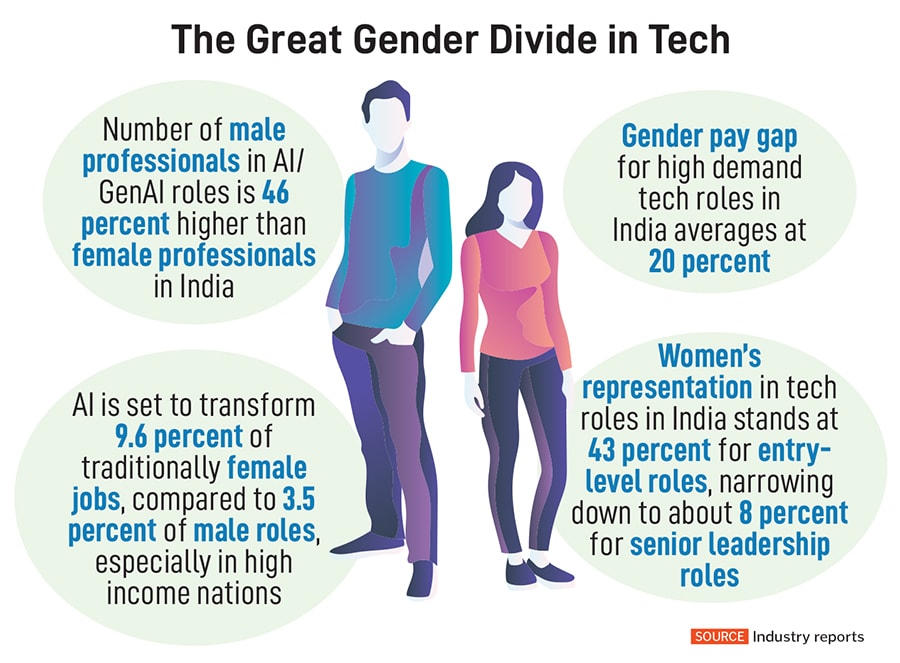Is AI widening the gender gap in the tech industry?
With large-scale AI adoption across enterprises, entry- and mid-level women in tech face a new challenge that companies need to address


For Pune-based Deepti V, a product manager in an IT services firm, shoring up certifications related to artificial intelligence (AI) is central to career growth. The finance company where she is deployed on a project has begun discussions on hiring an AI risk manager who will decide the processes that can be automated. “Once the automation takes effect across teams, it will result in some people being removed. In order to stay relevant or reach a better profile in, say, two or three years, it is important to complete as many certifications as possible,” says the 40-year-old. At present her interaction with AI is using Microsoft’s Copilot to automate routine work such as tracking and status updates for her project, in addition to querying the AI agent about data on key aspects of the project.
Deepti falls within the bracket of entry- and mid-level women employees in the Indian IT/ITeS sector who show high adoption of generative AI (GenAI). According to a survey by Nasscom and consultancy firm BCG in 2024, nearly 79 percent women in senior roles in India adopted GenAI for work, compared to 88 percent male peers, lagging by 9 basis points. Globally, adoption of GenAI by women in leadership roles stood at 76 percent, 12 basis points ahead of men.
In a country where the funnel of women narrows towards senior leadership roles in tech industries, large-scale adoption of AI in enterprises is only likely to widen the gap between female and male employees in the sector, believe industry experts.
Also Read: With AI, India's employment market is evolving, not shrinking: Madhu Kurup
Adoption of GenAI across sectors is likely to impact repetitive, low- and mid-skilled tasks, creating a barrier to entry for all. The Nasscom-BCG report estimates that, in India, the number of male professionals in AI/GenAI roles is 46 percent higher than female professionals. Female representation in tech roles follows a downward trend from 43 percent at entry-level roles to between 4 and 8 percent of executive level roles. These factors indicate the need for a shift in focus on the kind of roles women in the tech workforce need to be trained in, and reskilling them accordingly.

“The formal sector’s adoption of AI poses a specific and disproportionate risk to women at entry and mid-levels. In fact, a UN report indicated that nearly 28 percent of jobs held by women globally are at risk from AI, versus 21 percent of men’s jobs,” says Milind Shah, managing director at tech talent company Randstad Digital India. He adds that the primary disruption brought about by AI adoption is not going to be job elimination but reconstitution of roles. “AI automates tasks within a job description, forcing humans to shift focus to higher-order functions,” says Shah. “For mid-level professionals, the strategic imperative is to transition their expertise from routine execution to becoming supervisors of AI output, managing data integrity, prompt engineering, and ethical governance. This increases their job scope and value, mitigating the risk of their roles getting redundant.”
Historically, women have made up for bulk of operations, administrative and back-office functions, which are ripe for disruption due to AI adoption, says Shreya Krishnan, managing director–India at global non-profit AnitaB.org, which works on equitable career opportunities and advancement of women in tech. “The demand for an AI workforce in India is expected to grow at a CAGR of 15 percent by 2027, and the lack of women’s representation in the field is alarming. Women in AI are only operators, they are not playing with the technology. This is similar to when computers first came around, women were employed to operate them as typists, not engineers,” she adds. “This is important as AI has picked up human biases and if women were active participants in training AI models, this wouldn’t have happened. Women need to be given access to AI tools from the start.”
Shah of Randstad Digital India adds that while the overall gender pay gap in the Indian tech sector was around 16 percent, the disparity widens for high-demand tech roles, crossing 20 percent. In order to achieve pay parity, there is a need to transition beyond foundational AI literacy to specialised domains.

With these factors at play, it is imperative that the divide does not grow due to adoption of AI. “Tech companies in India have become choosy on what skills they are looking for. The onus also falls on women, in addition to the industry-specific programmes at play, to be at the forefront,” says Sangeeta Gupta, senior vice president and chief strategy officer at Nasscom. “For example, GCCs tend to hire through hackathons; hence, women need to participate in these for better opportunities. That said, there has to be clear intent from the companies to ensure there is sizeable representation of women at these events.” She further says that being hired in the face of AI adoption is a skill difference and can be addressed accordingly.
Shah of Randstad adds that maintaining DEI (diversity, equity and inclusion) goals in the current environment will require treating equity as a business imperative. “Implementing clear ethical policies and mandating regular, independent bias audits of all AI systems used in talent processes to ensure representative data sets are used; ensuring mandatory diversity in AI development teams to prevent biases from being coded into the technology, and proactively using AI tools to mitigate human bias by removing gendered language from job descriptions are key for maintaining DEI goals,” says.
In addition to enterprise-specific initiatives, state and central governments too have been increasing their focus on training women in AI skills. AI Kiran, launched by trust tech organisation Verix in collaboration with the office of Principal Scientific Adviser and INK Women, aims to build a national platform for recognition, support and mentorship for women in AI. The Ministry of Skill Development and Entrepreneurship signed an MoU with Microsoft earlier this year to launch the skilling initiative, AI Careers for Women, in partnership with state governments, to impart training in AI through 30 centres of excellence and 150 educational institutions across six states.

Priyanka Kamath, founder and CEO of 100 GIGA, has partnered with AI Kiran to train undergraduate girl students in AI. “We also conduct workshops with organisations such as FICCI FLO, WEHub in Telangana and AI Kiran for training women in the workforce,” adds Kamath.
With these opportunities and push from enterprises, the avenues for upskilling are clear. For tech sector employees like Deepti, certification and upskilling are going to be key to remain relevant to the fast-evolving workforce requirements.
First Published: Nov 10, 2025, 15:14
Subscribe Now(This story appears in the Nov 04, 2025 issue of Forbes India. To visit our Archives, Click here.)
